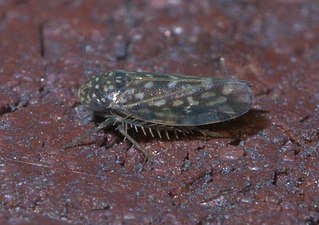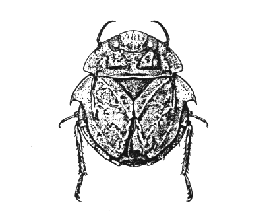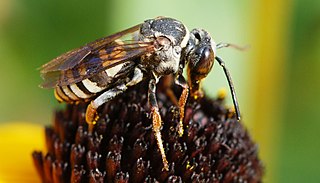
Nepomorpha is an infraorder of insects in the "true bug" order (Hemiptera). They belong to the "typical" bugs of the suborder Heteroptera. Due to their aquatic habits, these animals are known as true water bugs. They occur all over the world outside the polar regions, with about 2,000 species altogether. The Nepomorpha can be distinguished from related Heteroptera by their missing or vestigial ocelli. Also, as referred to by the obsolete name Cryptocerata, their antennae are reduced, with weak muscles, and usually carried tucked against the head.

Naucoridae is a small family of insects commonly known as the creeping water bugs and saucer bugs. They are similar in appearance and behavior to Belostomatidae, but considerably smaller, at 0.5–2 cm (0.2–0.8 in) long. Naucoridae are found around the world, but the greatest diversity is in tropical regions. They inhabit a wide range of freshwater habitats, ranging from still waters like ponds, to flowing rivers and even torrential streams. There are about 400 species in 46 genera in 8 subfamilies.

Ambrysus amargosus, the Ash Meadows naucorid, is a small insect of the Naucoridae family. They were first identified by Ira La Rivers in 1953. They live in the waters of Point of Rocks Springs, in the east-central region of Ash Meadows National Wildlife Refuge in Nye County, Nevada. Because of changes to their habitat, this species lives only in a few small stream channels. Scientific over-collection and introduced predatory fish are the main threats to these insects. They are the first species to be listed as threatened under the Endangered Species Act (ESA). They are also currently protected under the Ash Meadows National Wildlife Refuge (NWR)

Angus Munn Woodbury was an American zoologist and ecologist from Utah. He was professor at the University of Utah for over 20 years, and also worked for many years as a ranger-naturalist at Zion National Park. He produced over 100 publications, many focused on the biology of reptiles and birds, but also on insects, ecological succession, and the history of Utah. He and his wife of 55 years, Grace Atkin Woodbury, died in an automobile collision on August 1, 1964, near Loveland, Colorado.

Xestocephalus lunatus is a species of leafhopper in the family Cicadellidae.

Limnocoris moapensis, the moapa warm springs naucorid, is a species of creeping water bug in the family Naucoridae.

Limnocoris is a genus of creeping water bugs in the family Naucoridae. There are more than 70 described species in Limnocoris.

Pelocoris femoratus is a species of creeping water bug in the family Naucoridae. It is found in Central America, North America, and South America. They prefer still water with a high density of vegetation and eggs are laid on submerged plants. They feed on other arthropods and actively catch them while swimming. They are active from spring to autumn and can give a painful bite if not handled properly.

Pelocoris is a genus of creeping water bugs in the family Naucoridae. There are about 15 described species in Pelocoris.
Megamelus lunatus is a species of delphacid planthopper in the family Delphacidae. It is found in North America.
Ambrysus circumcinctus is a species of creeping water bug in the family Naucoridae. It is found in Central America and North America.

Ambrysus is a genus of creeping water bugs in the family Naucoridae. There are more than 90 described species in Ambrysus.
Ambrysus mormon, the creeping water bug, is a species of creeping water bug in the family Naucoridae. It is found in the western United States and northwestern Mexico.
Ambrysus occidentalis is a species of creeping water bug in the family Naucoridae. It is found in Central America and North America.
Limnocoris lutzi is a species of creeping water bug in the family Naucoridae. It is found in Central America and North America.
Cryphocricos hungerfordi is a species of creeping water bug in the family Naucoridae. It is found in Central America and North America.
Ambrysus californicus is a species of creeping water bug in the family Naucoridae. It is found in North America.

Triepeolus lunatus is a species of cuckoo bee in the family Apidae. It is found in North America from Canada to northern Mexico. Triepeolus lunatus tends to live in forest edges and meadows.
Ambrysus puncticollis is a species of creeping water bug in the family Naucoridae. It is found in Central America and North America.

Pelocoris balius is a species of creeping water bug in the family Naucoridae. It is found in Florida. In the Everglades, P. balius is locally common in shorter hydroperiod sites.








